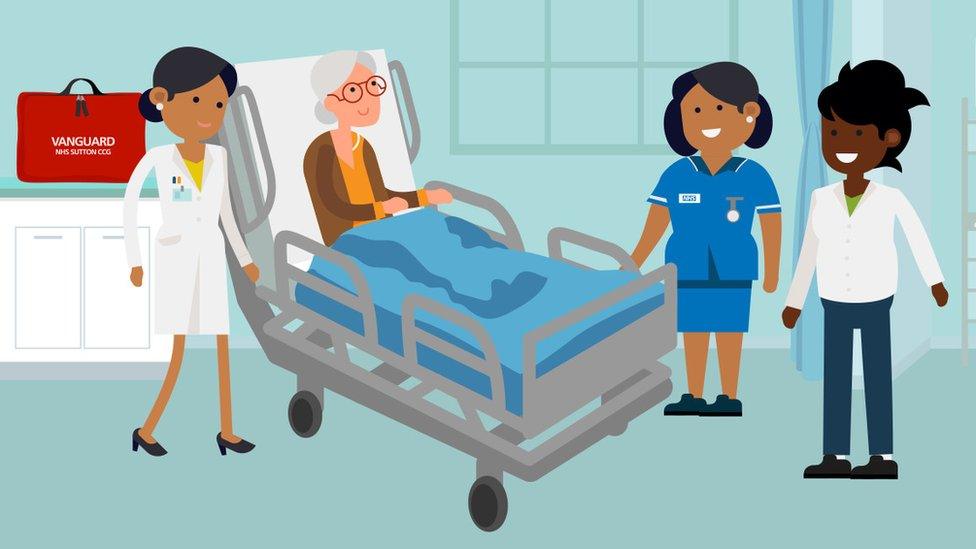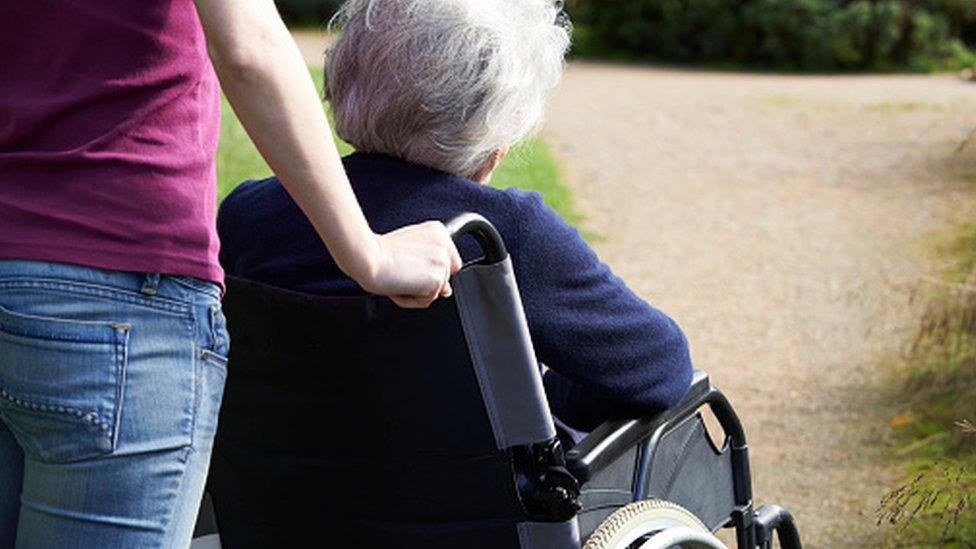How red bags are bringing NHS and care homes closer
- Published

Like many good ideas, the way the NHS and care sectors in the London borough of Sutton are working together more closely is a relatively simple concept.
When a care home resident needs to go into a hospital, a red bag is packed for them.
It contains their details, vital information about their health conditions, supplies of medicine, and a change of clothes for when they are ready to be discharged.
"You would not believe how many people face delays simply because clothes can't be found for them," says Mary Hopper, a senior NHS manager in Sutton. "You have staff going to lost property trying to find them something to fit."
The initiative also sees a member of the care home staff visiting the patient in hospital within 48 hours of admission.
And this all helps doctors and nurses treat them more effectively.
The result is older people are spending less time in hospital - eight days, which is four fewer than before the scheme was set up.
That is good for the individual and good for the health service.
But the red bag scheme is just one of the ways the NHS and care homes are working together.
Drop in A&E visits
GPs have also been employed to carry out regular visits of care homes, with each resident now receiving six-monthly check-ups.
A pharmacist is on hand to visit homes to carry out medicine reviews.
And district nurses have been used to train care home staff in dementia, falls and diabetes.
It certainly seems to be working.
Since the project started a year ago, there has been a 10% drop in visits to A&E.
Those running care homes are, unsurprisingly, full of praise.
Patricia Fyfe, the manager of St Jude's care home, says it has been really "eye-opening" to see what can be achieved through collaboration.

Sutton is not the only area where the NHS is forging closer links with care homes.
It is one of six "vanguard" areas in England given funding to explore new ways of working.
This has been done in recognition of the fact that the NHS has - in the words of Ms Hopper - turned its back on the care sector.
She says the closure of many long-stay hospitals 20 years ago means the responsibility for caring for sick older people has increasingly fallen on the care sector - with little input from the NHS.
The sentiment is one the care sector wholeheartedly shares.
Prof Martin Green, of Care England, which represents providers, says there is no reason why residents in care homes should get an "inferior" service to the one someone in their own home would get.
But all the evidence suggests they do.
The Care Quality Commission looked at the issue a few years ago and found most of the 81 care homes it asked did not receive regular visits from GPs.
The result has been that care home managers have had to pay GPs retainers to ensure they visit - with reports that some are as high as £20,000 a year.
So what is the solution?
If the experience of Sutton - and the other places doing good work in this area - is anything to go by, it is forging a shared approach.
Ever since the separate systems of social care and health care were created after World War Two, they have been treated as distinct services - one run by councils at a local level, the other organised centrally by government.
But, increasingly, as the population ages, that is looking out of date.
The government has set up a shared pot - called the Better Care Fund - to encourage local government and the NHS to work together.
The fund is worth just over £5bn this year - but that is less than 5% of the combined health and care budgets, which is why some people want the government to go even further and merge the two sectors completely.
Such a radical move is probably some way off yet, if it is to happen at all, but what is certain is that the futures of the two sectors are inextricably linked.